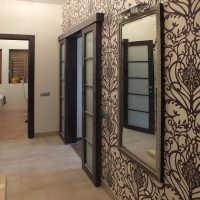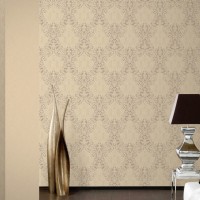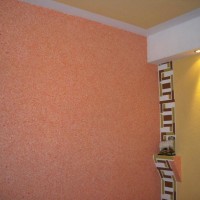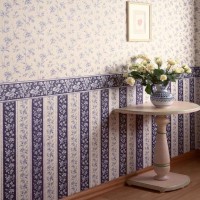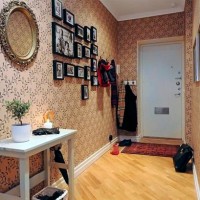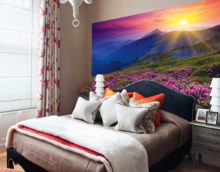How to choose wallpaper for the hallway and corridor photo ideas for the apartment
A tastefully decorated corridor is the dream of every homeowner. Since there is not much furniture in the entrance room, the focus is on wall decoration. Exactly wallpaper for the hallway and corridor create a first impression, and photo ideas for an apartment help you choose a stylish design. Sometimes it’s enough to change the wall decoration, and the room is noticeably transformed. Wallpaper towels will hide unsightly areas and highlight individual areas in the room. When buying, you should pay attention to the color and texture of this finishing material.

Tastefully decorated corridor - every homeowner's dream
Content
- 1 Wallpaper in history
- 2 Types of Wallpaper
- 3 Useful Tips
- 4 Delicate Pastel Colors
- 5 Monochrome ensembles
- 6 Bright combinations
- 7 Classic and modern
- 8 Floral motifs
- 9 Abstraction
- 10 Strict stripes
- 11 Photowall-paper
- 12 How not to make out the corridor and the hallway
- 13 How to present a wallpaper in a favorable light
- 14 Wallpaper in the corridor
- 15 Wallpaper for the hallway and the corridor for the apartment 45 photo ideas:
Wallpaper in history
The first copies appeared in China in 200 BC. Then the canvas was made from rice paper. The British were the first to adopt manufacturing technology from the Chinese. In Europe, then the walls were upholstered with fabric. But soon the fashion for new finishing material came to France, and then other European states. Images on the canvases were applied through a stencil, and to create a complex drawing, an artist had to be hired. Wallpaper was expensive, only a king or a rich nobleman could afford to decorate a room with them.

Bright hallway in Provence style with original floral wallpaper
The era of paper wallpaper is considered the first half of the 20th century. Then, thanks to the advent of production machines, wallpaper factories were able to abandon manual labor. Product prices have declined, so it has become in high demand. Nowadays, many varieties of wallpaper with an exquisite design are produced - from budget to premium.

The era of paper wallpapers is considered the first half of the 20th century
Types of Wallpaper
The walls in the corridor and hallway are subject to pollution. Therefore, it is recommended to purchase wear-resistant products from which it is easy to erase dust and soot. Vinyl wallpaper is dense, the top layer is covered with a protective film. There are many options with a bright design, you can always find an interesting pattern. A significant advantage is the ability of the coating to hide small defects and uneven walls.

Large wallpaper corridor with original design
Liquid wallpaper reminds the texture of decorative plaster. They are often used for pasting walls in the corridor. They are a dry powdery finishing material. Diluted with water and applied to the wall with a spatula.
The most durable are cullet. They can be painted with acrylic paint. The embossed surface will give an original texture. If you like natural materials and want to improve sound insulation, pay attention to cork coverings. They are always natural warm hues. Non-woven wallpaper can imitate the texture of stone or wood.
The cloth finish looks impressive. But not everyone can afford to buy expensive fabric and invite a specialist who will attach it to the walls.A compromise solution will be wallpaper on a paper basis with a fabric coating. They are glued with wallpaper glue.

The most durable are considered cullet.
Paper wallpapers must be replaced after 2-3 years, and if the apartment has pets, the coating may become unusable after a year. If the wall decoration is boring, you can easily replace the decorative coating. Due to the affordable cost of the material, it is possible to frequently update the situation. The advantage of paper is that it breathes, so fungi do not breed under it. Russian and foreign manufacturers produce dense paper wallpaper from two layers - duplex. Such a wall coating is much more durable.
Tip. Before decorating, align the walls. Thick non-woven wallpaper will mask only minor irregularities.
Useful Tips

Decorating the hallway and the corridor with dark shades
Each apartment has its own layout features. Therefore, depending on the parameters of the room, pay attention to the following properties:
- In small apartments, the corridor is combined with the entrance hall, and most of the walls are occupied by doorways. Placing huge murals on such a limited area is unlikely to succeed.
- A narrow passage can visually expand the wallpaper with horizontal stripes.
- If there is free space, enliven the interior with photo wallpaper or decorative panels.
Most of the windows in the corridor and entrance area do not exist. Therefore, they try to fill the room with light. A similar effect is not difficult to achieve by picking up wallpapers of light shades. Both monophonic variations and canvases with a fine pattern are suitable.

Striped wallpaper for the classic design of the corridor in the apartment
Tip. In a small corridor, be careful with wallpapers that imitate natural stone or brickwork. Use them as a bright accent, and the main background should be neutral.
Delicate Pastel Colors

Small hallway and hallway with white wallpaper
To fill the home with an atmosphere of comfort, use airy pastel colors. Peach, pale pink, mint, light yellow - perfect for decorating a cozy nest. You can use several close shades and combine them with each other.
Monochrome ensembles

Stylish corridor design with warm-colored orange wallpaper
Classical black and white combinations look expressive and give the room additional volume. Non-color wallpapers due to their versatility have gained popularity. They are combined with almost any design - from classic to modern.
Patterned monochrome canvases are suitable for the hallway. You can choose the original version - a stylization for a newspaper or black and white murals with a city landscape. A bold decision will be the alternation of black and white paintings.

Interior of a small patterned wallpaper corridor
Bright combinations
Designers often use a combination of finishing materials. In most cases, two types of wallpaper are involved. One canvas simulates a wall panel, it is glued to the bottom, and the other is placed at the top. Wallpaper should be combined in style. Manufacturers include ready-made combinations of wallpaper-companions in their collections. Therefore, you are unlikely to have to choose the right combination yourself.
The panels imitating the wall panel are usually plain, with a picture of the texture of the tree or vertical stripes. For the upper part, floral patterns are most often used. Sometimes the products are selected that are identical in color, but differ in texture.

Stylish wallpaper for the hallway and corridor in a small apartment
Useful information. Wallpaper for the upper area, choose a lighter shade.
The trend of recent years is a combination of white with bright red or yellow. This is a great solution if you want to add saturated colors. One of the walls is decorated with a rich shade of wallpaper, and the rest are left neutral. This technique allows you to make the interior voluminous and draw attention to important details.

Hallway interior with dark stylish wallpaper
Doorways do not need to be further allocated. To emphasize the noble lines of designer doors, choose light wallpapers without a picture. You can also place LED lights around the perimeter of each opening. Borders will help hide the seam between two horizontal canvases.
Tip. Do not get carried away with borders, minimalism is in fashion. Even in an antique interior with an abundance of decor, the walls make the backdrop for furniture.
Spacious entrance hall with bright stylish wallpaper
Classic and modern
Vintage patterns are in fashion. They can be both concise and restrained, and very bright. Patterned panels completely cover the wall or use a combination with plain ones. The wall at the edges is painted white or covered with glass. For the interior in the classical style, you can select several panels from the wallpaper and place them inside the wooden frames.

Classic style of wallpaper for a strict and concise design of the hallway
Tip. In order for the wallpaper to resonate with the surroundings, they can also be pasted over the side walls of the cabinets or door facades.
Floral motifs

wallpaper for a long corridor
Traditionally, flowers are placed on the wallpaper. Inflorescences can be large - on the floor of the wall or represent a small repeating pattern. The classic option for decorating the walls in the corridor is with a diamond-shaped pattern with monograms, curls and floral arrangements.
Abstraction

Paper wallpapers must be replaced after 2-3 years, and if the apartment has pets, the coating may become unusable after a year
Light walls show dirt. If you don’t want to spend a lot of time cleaning or regularly re-sticking your canvases, select products with an abstract pattern. Against the background of a bright pattern, spots are less striking.

To fill the home with an atmosphere of comfort, use airy pastel colors
Strict stripes
Striped wallpaper can both visually increase and reduce space. They are placed together with companion wallpapers or plain fabrics. To raise the ceiling, use vertical stripes, horizontal, on the contrary, expand the space.

Wallpaper should be combined in style
Tip. It is desirable that the design of the corridor overlap with the design of living rooms.
Photowall-paper
In the corridor it’s not necessary to set aside all the walls under the mural. To visually increase the space, use compact panels that look like a picture. You can even get an imitation of a window that overlooks a forest or park. Images of flowers are always relevant. Please note that the photographs of the sea and palm trees are quite dark. In addition, the blue color makes crowded rooms heavier.
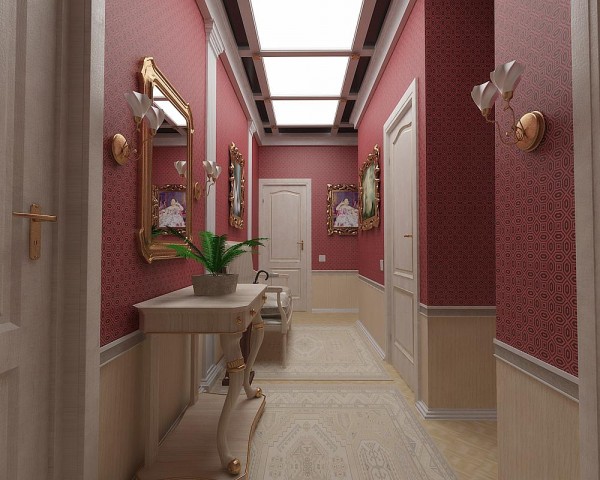
Doorways do not need to be further allocated.
Tip. For a dark corridor, choose photo wallpaper with a bright pattern in warm colors.
How not to make out the corridor and the hallway
To avoid repair errors, follow these guidelines:
- The walls should not be dark, otherwise the corridor will appear gloomy.
- Wallpaper with a 3D effect, with large images of fruits or flowers will visually reduce the room.
- Excessive wall decor will be annoying.
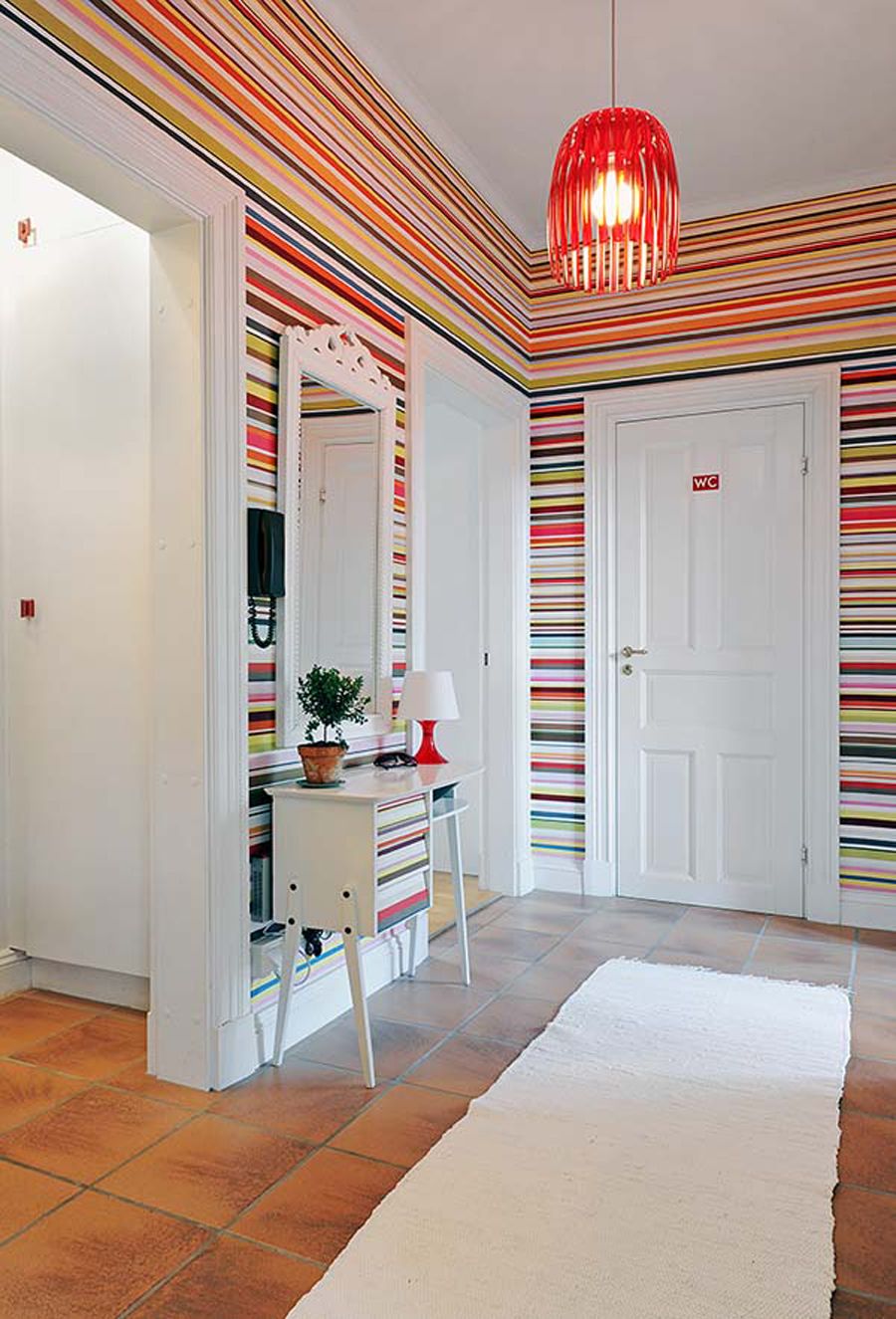
If you don’t feel like spending a lot of time cleaning or regularly re-sticking your canvases, choose products with an abstract pattern
How to present a wallpaper in a favorable light
Lighting plays an important role. A corridor without lights seems dark. Therefore, it is advisable to install powerful light sources under the ceiling.In a long corridor you can place several lamps in a row. So that the bulbs do not shine in your eyes, get lampshades.
Do not give up black wallpaper if they are suitable for the style of your home. To fill the space with light, place wall lights in addition to the chandelier.

To visually increase the space, use compact panels that look like a picture
Wallpapering does not take much time, and the result is immediately noticeable. Therefore, this coating is widespread. Having figured out in advance which wallpaper is suitable for the corridor and hallway, you will find exactly what you need in the store.
Wallpaper in the corridor











